Author Isak Saba
Sámi soga lávlla
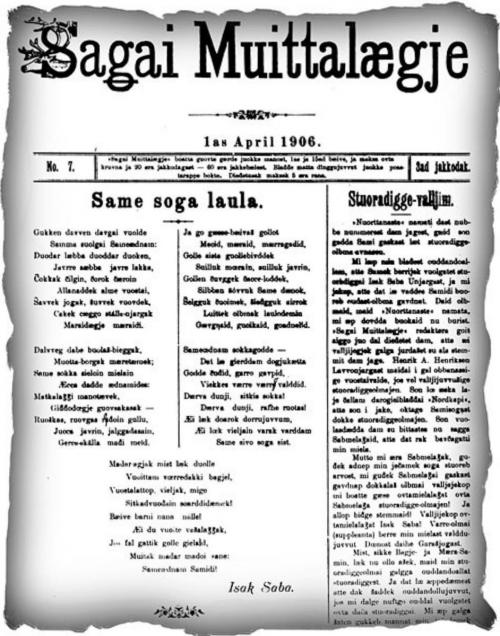
1. Il testo originale in Sami Settentrionale (Grafia attuale normalizzata)
(Continues)
(Continues)
Contributed by Juha Rämö 2016/11/21 - 13:28
Song Itineraries:
Anthems and Anti-Anthems
2. Il testo originale in Sami di Luule, di Sigga Tuolja-Sandström
2. Lyrics in Luule Sami, by Sigga Tuolja-Sandström
Sigga Maria Tuolja-Sandström (1921-2011) var en svensk/lulesamisk författarinna och lärarinna. Hon har skrivit flera böcker, och har översatt den samiska nationalsången till lulesamiska. Den här översättningen är med i Norsk salmebok 2013
Sigga Maria Tuolja-Sandström (født 1921, død 2011) var en svensk/lulesamisk forfatter og lærer.Hun har skrevet flere bøker, og har oversatt den samiske nasjonalsangen til lulesamisk. Denne oversettelsen er med i Norsk salmebok 2013.
Sigga Maria Tuolja-Sandström (1921-2011) è stata una insegnante e autrice Sami di Luule, di cittadinanza svedese. Ha scritto numerosi libri, e ha tradotto l'inno nazionale Sami in Sami di Luule. Tale traduzione è presente anche nel Salterio Norvegese del 2013.
Sigga Maria Tuolja-Sandström (1921-2011) was... (Continues)
2. Lyrics in Luule Sami, by Sigga Tuolja-Sandström
Sigga Maria Tuolja-Sandström (1921-2011) var en svensk/lulesamisk författarinna och lärarinna. Hon har skrivit flera böcker, och har översatt den samiska nationalsången till lulesamiska. Den här översättningen är med i Norsk salmebok 2013
Sigga Maria Tuolja-Sandström (født 1921, død 2011) var en svensk/lulesamisk forfatter og lærer.Hun har skrevet flere bøker, og har oversatt den samiske nasjonalsangen til lulesamisk. Denne oversettelsen er med i Norsk salmebok 2013.
Sigga Maria Tuolja-Sandström (1921-2011) è stata una insegnante e autrice Sami di Luule, di cittadinanza svedese. Ha scritto numerosi libri, e ha tradotto l'inno nazionale Sami in Sami di Luule. Tale traduzione è presente anche nel Salterio Norvegese del 2013.
Sigga Maria Tuolja-Sandström (1921-2011) was... (Continues)
SÁME MÁTTO LÁVLA
(Continues)
(Continues)
Contributed by Juha Rämö 2016/11/21 - 13:30
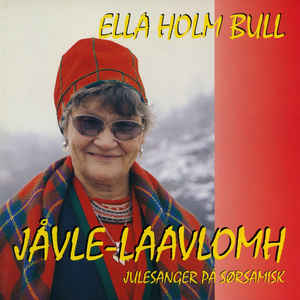
3. Il testo originale in Sami Meridionale, di Ella Holm Bull
3. Lyrics in Southern Sami, by Ella Holm Bull
Ella Holm Bull (riegádan golggotmánu 12. beaivvi 1929 Snoasas, jápmán čakčamánu 21. beaivvi 2006 seamma báikkis) lei sámegiel oahpaheaddji ja girječálli. Son lei dovddusin iežas áŋgirvuođaines lullisámegielas. Son válljejuvvui Norgga vuosttaš Sámediggái jagis 1989. Sámedikkis son ovddastii Oktasašlisttu Oarjelsámeguovllu Sápmelaččaid, Oarjelsámeguovllu válgabires. Sámedikkis doaimmadettiin son lei Sámedikkeráđi ja organisašunlávdegotti miellahttun. Holm Bull lei guhká Snoasa sámeskuvllas oahpaheaddjin. Ovttas professor Knut Bergslandain dagaiba soai Bergsland-Bull-riektačállima, lullisámi riektačállima jagis 1974. Go son jámi lei son juste bálkkahuvvon čállit "Sámi historjá Røyrvikas ja dan birrasis” (Den samiske historien i Røyrvik og omegn), ruhtaduvvon Davvi-Trøndelaga filkkadikki... (Continues)
3. Lyrics in Southern Sami, by Ella Holm Bull
Ella Holm Bull (riegádan golggotmánu 12. beaivvi 1929 Snoasas, jápmán čakčamánu 21. beaivvi 2006 seamma báikkis) lei sámegiel oahpaheaddji ja girječálli. Son lei dovddusin iežas áŋgirvuođaines lullisámegielas. Son válljejuvvui Norgga vuosttaš Sámediggái jagis 1989. Sámedikkis son ovddastii Oktasašlisttu Oarjelsámeguovllu Sápmelaččaid, Oarjelsámeguovllu válgabires. Sámedikkis doaimmadettiin son lei Sámedikkeráđi ja organisašunlávdegotti miellahttun. Holm Bull lei guhká Snoasa sámeskuvllas oahpaheaddjin. Ovttas professor Knut Bergslandain dagaiba soai Bergsland-Bull-riektačállima, lullisámi riektačállima jagis 1974. Go son jámi lei son juste bálkkahuvvon čállit "Sámi historjá Røyrvikas ja dan birrasis” (Den samiske historien i Røyrvik og omegn), ruhtaduvvon Davvi-Trøndelaga filkkadikki... (Continues)
SAEMIEJ LAAVLOME
(Continues)
(Continues)
Contributed by Juha Rämö 2016/11/21 - 13:32
4. Il testo originale in Sami di Skolt, di Sinikka Semenoja e Anni Feodoroff
4. Lyrics in Southern Sami, by Sinikka Semenoja and Anni Feodoroff
4. Lyrics in Southern Sami, by Sinikka Semenoja and Anni Feodoroff
SÄÄ´MSOOǤǤ LAULL
(Continues)
(Continues)
Contributed by Juha Rämö 2016/11/21 - 13:34
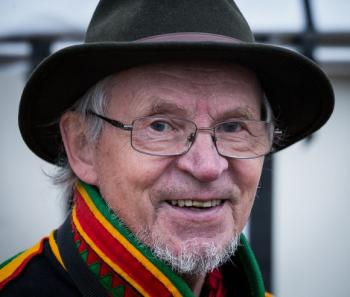
5. Il testo originale in Sami di Inari, di Matti Morottaja, o Kuobž-Saammâl Matti
5. Lyrics in Inari Sami, by Matti Morottaja, or Kuobž-Saammâl Matti
Ascolta MP3 / Listen MP3
Matti Heikki Ilmari Morottaja dahjege Kuobžâ-Saammâl Matti (riegádan juovlamánu 28. 1942) lei anáraš Suoma Sámedikki lahttu. Son lea maid bargan áŋgirit anárašgiela ovdii. Son lea leamašan Anarâškielâ servi-searvvi ságadoalli searvvi vuođđudeami rájes. Su gánddain Petteriin ja Mikkâliin lea maid ovddidan anárašgiela. Morottaja fidjii Suomen Kulttuurirahasto Mikael Agricola -medaljja cuoŋománu 1. beaivve 2007. Matti Morottaja lea doaimmahan girjji Tovlááh mainâseh jagis 1996 Girjjis leat máidnasat ja muitalusat Anarâš- ja Sápmelaš-bláđiin, jagiin 1968-70 čohkkejuvvon jietnabáttiin ja Aanaarkiela čájttuzeh -čoaggáldagas. Ovttas Mattus Ilmariin Morottaja lea doaimmahan noveallačoaggáldaga Kyelisieidi maccâm já eres... (Continues)
5. Lyrics in Inari Sami, by Matti Morottaja, or Kuobž-Saammâl Matti
Ascolta MP3 / Listen MP3
Matti Heikki Ilmari Morottaja dahjege Kuobžâ-Saammâl Matti (riegádan juovlamánu 28. 1942) lei anáraš Suoma Sámedikki lahttu. Son lea maid bargan áŋgirit anárašgiela ovdii. Son lea leamašan Anarâškielâ servi-searvvi ságadoalli searvvi vuođđudeami rájes. Su gánddain Petteriin ja Mikkâliin lea maid ovddidan anárašgiela. Morottaja fidjii Suomen Kulttuurirahasto Mikael Agricola -medaljja cuoŋománu 1. beaivve 2007. Matti Morottaja lea doaimmahan girjji Tovlááh mainâseh jagis 1996 Girjjis leat máidnasat ja muitalusat Anarâš- ja Sápmelaš-bláđiin, jagiin 1968-70 čohkkejuvvon jietnabáttiin ja Aanaarkiela čájttuzeh -čoaggáldagas. Ovttas Mattus Ilmariin Morottaja lea doaimmahan noveallačoaggáldaga Kyelisieidi maccâm já eres... (Continues)
SÄÄMI SUUVÂ LAAVLÂ
(Continues)
(Continues)
Contributed by Juha Rämö 2016/11/21 - 13:36
6. Il testo originale in Sami di Kildin
6. Lyrics in Kildin Sami
Il Sami di Kildin è parlato da circa 300 persone di etnia Sami nella penisola di Kola, appartenente alla Federazione Russa; si tratta di un dialetto Sami parecchio divergente dagli altri, divergenza accentuata anche dal fatto che è scritto ufficialmente con una forma di alfabeto cirillico. L'autore della versione dell'inno nazionale Sami in Sami di Kildin non è menzionato nelle fonti disponibili (Wikipedia e Samskaja Simvolika). La versione è accompagnata da un tentativo di trascrizione in caratteri latini.
Kildin Sami is spoken by about 300 people of Sami nationality in the Kola Peninsula, belonging to the Russian Federation; Kildin Sami differs considerably from the other Sami languages, a difference made even more evident by the Cyrillic script in official use for the language. The author of the Kildin Sami version of... (Continues)
6. Lyrics in Kildin Sami
Il Sami di Kildin è parlato da circa 300 persone di etnia Sami nella penisola di Kola, appartenente alla Federazione Russa; si tratta di un dialetto Sami parecchio divergente dagli altri, divergenza accentuata anche dal fatto che è scritto ufficialmente con una forma di alfabeto cirillico. L'autore della versione dell'inno nazionale Sami in Sami di Kildin non è menzionato nelle fonti disponibili (Wikipedia e Samskaja Simvolika). La versione è accompagnata da un tentativo di trascrizione in caratteri latini.
Kildin Sami is spoken by about 300 people of Sami nationality in the Kola Peninsula, belonging to the Russian Federation; Kildin Sami differs considerably from the other Sami languages, a difference made even more evident by the Cyrillic script in official use for the language. The author of the Kildin Sami version of... (Continues)
СОАМЕ ШУРЬМУСЕ ЛА̄ВВЛ
(Continues)
(Continues)
Contributed by Juha Rämö 2016/11/21 - 13:37
9. Traduzione norvegese (bokmål) di Jacob Børretzen
9. Norwegian (Bokmål) Translation by Jacob Børretzen
Jacob Børretzen (August 30, 1900 – November 17, 1989)was a Norwegian hymnwriter and linguist. Børretzen was born in Enge in Etne, Hordaland County, Norway, the son of Vilhelm Severin Børretzen and Sigrid Børretzen. He was the secretary of Norwegian Sami Mission (Norwegian: Norges Finnemisjonsselskap, since 1966 the Norges Samemisjon) and a member of the hymnal commission for the Sami hymnal Gir'ko-sál'bmagirji, which was published in 1957. He translated hymns into Sami, and is represented by a hymn he translated in the 1985 Norwegian hymnal and its supplement Salmer 1997 (1997 Hymns). He also published the volume Liten samisk grammatikk (Little Sami Grammar) in 1966. - Translation credited to Jacob Børretzen from no.wikipedia
Jacob Børretzen (født 30. august 1900, død 17. november 1989)... (Continues)
9. Norwegian (Bokmål) Translation by Jacob Børretzen
Jacob Børretzen (August 30, 1900 – November 17, 1989)was a Norwegian hymnwriter and linguist. Børretzen was born in Enge in Etne, Hordaland County, Norway, the son of Vilhelm Severin Børretzen and Sigrid Børretzen. He was the secretary of Norwegian Sami Mission (Norwegian: Norges Finnemisjonsselskap, since 1966 the Norges Samemisjon) and a member of the hymnal commission for the Sami hymnal Gir'ko-sál'bmagirji, which was published in 1957. He translated hymns into Sami, and is represented by a hymn he translated in the 1985 Norwegian hymnal and its supplement Salmer 1997 (1997 Hymns). He also published the volume Liten samisk grammatikk (Little Sami Grammar) in 1966. - Translation credited to Jacob Børretzen from no.wikipedia
Jacob Børretzen (født 30. august 1900, død 17. november 1989)... (Continues)
SAMEFOLKETS SANG
(Continues)
(Continues)
Contributed by Juha Rämö 2016/11/21 - 13:39
10. Traduzione svedese
10. Swedish translation
10. Swedish translation
Nelle varie fonti (differenti edizioni di Wikipedia, National Anthems Forum) l'autore della traduzione non è indicato; lo svedese usato presenta degli arcaismi (come la forma plurale dei verbi). Il corretto layout delle strofe è riprodotto da National Anthems Forum.
The various sources used (different Wikipedia editions, National Anthems Forum) do not state the translator's name; the Swedish used shows old forms (e.g., the plural form of verbs). The correct verse layout is reproduced from National Anthems Forum [RV]
The various sources used (different Wikipedia editions, National Anthems Forum) do not state the translator's name; the Swedish used shows old forms (e.g., the plural form of verbs). The correct verse layout is reproduced from National Anthems Forum [RV]
SAMEÄTTENS SÅNG
(Continues)
(Continues)
Contributed by Juha Rämö 2016/11/21 - 13:40
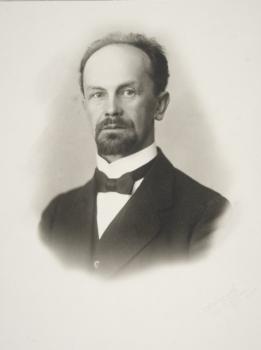
11. Traduzione finlandese di Otto Manninen
11. Finnish translation by Otto Manninen
Otto Manninen (13 August 1872, Kangasniemi – 6 April 1950, Helsinki) was a Finnish writer, poet, and a celebrated translator of world classics into Finnish language. Along with Eino Leino in the early 20th century, he is considered as a pioneer of Finnish poetry. Manninen translated the works of Homer, Sophocles, Euripides, Heine, Ibsen, Petőfi and Runeberg into Finnish. - Read Article
Otto Manninen (13. elokuuta 1872 Kangasniemi – 6. huhtikuuta 1950 Helsinki) oli suomalainen kirjailija, runoilija ja suomentaja. Ystävänsä Eino Leinon ohella hän oli 1900-luvun alkupuolen suomalaisen runouden uranuurtajia. - Read Article
Otto Manninen (født 13. august 1872 i Kangasniemi i Finland, død 6. april 1950 i Helsingfors) var en finsk forfatter og oversetter.
Manninen var lektor ved Helsingfors universitet 1913–1937... (Continues)
11. Finnish translation by Otto Manninen
Otto Manninen (13 August 1872, Kangasniemi – 6 April 1950, Helsinki) was a Finnish writer, poet, and a celebrated translator of world classics into Finnish language. Along with Eino Leino in the early 20th century, he is considered as a pioneer of Finnish poetry. Manninen translated the works of Homer, Sophocles, Euripides, Heine, Ibsen, Petőfi and Runeberg into Finnish. - Read Article
Otto Manninen (13. elokuuta 1872 Kangasniemi – 6. huhtikuuta 1950 Helsinki) oli suomalainen kirjailija, runoilija ja suomentaja. Ystävänsä Eino Leinon ohella hän oli 1900-luvun alkupuolen suomalaisen runouden uranuurtajia. - Read Article
Otto Manninen (født 13. august 1872 i Kangasniemi i Finland, død 6. april 1950 i Helsingfors) var en finsk forfatter og oversetter.
Manninen var lektor ved Helsingfors universitet 1913–1937... (Continues)
SAAMEN SUVUN LAULU
(Continues)
(Continues)
Contributed by Juha Rämö 2016/11/21 - 13:41
13. Traduzione russa di Juha Janhunen e Tatijana Narlykova
13. Russian translation by Juha Janhunen and Tatijana Narlykova
13. Russian translation by Juha Janhunen and Tatijana Narlykova
La traduzione russa disponibile consta solo della 1a e della 5a strofa dell'inno. Nelle edizioni di Wikipedia (tranne quella russa, ovviamente) la traduttrice è indicata come “Narlykovoy”: si tratta di un errore dovuto alla scorretta interpretazione di un genitivo russo (Нарлыковой = “di Narlykova”).
The Russian translation available includes only verse 1 and 5 of the original anthem. The various editions of Wikipedia (except, of course, the Russian edition) state “Narlykovoy” as one of the translators: this is a fault due to uncorrect rendering of a Russian genitive form ( Нарлыковой = “Narlykova's”) [RV]
The Russian translation available includes only verse 1 and 5 of the original anthem. The various editions of Wikipedia (except, of course, the Russian edition) state “Narlykovoy” as one of the translators: this is a fault due to uncorrect rendering of a Russian genitive form ( Нарлыковой = “Narlykova's”) [RV]
НАЦИОНАЛЬНЫЙ ГИМН СААМОВ
(Continues)
(Continues)
Contributed by Juha Rämö 2016/11/21 - 13:42
7. Traduzione inglese di Ragnar Müller-Wille e Rauna Kuokkanen
7. English Translation by Ragnar Müller-Wille and Rauna Kuokkanen
7. English Translation by Ragnar Müller-Wille and Rauna Kuokkanen
SONG OF THE SAMI FAMILY
(Continues)
(Continues)
Contributed by Juha Rämö 2016/11/21 - 13:48
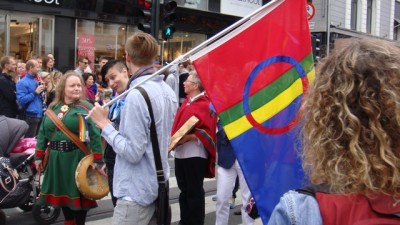
1. Il testo originale in Sami Settentrionale (Grafia originale)
1. Original Lyrics in Northern Sami (Original spelling)
Nota. Il testo nella grafia originale è trascritto da lokalhistoriewiki.no, ma sembra differire in alcuni punti da come appare sulle immagini presenti in rete della prima pagina di Saǥai Muittalægje del 1° aprile 1906. E' stato reso conto delle varianti (in nota con “SM”), tenendo presente che tutte le immagini presenti in rete sono di qualità molto bassa. Dalle immagini appare comunque che, sulla copia del giornale riprodotta in rete, appaiono alcune correzioni a mano (dell'autore stesso?). Quanto alle caratteristiche linguistiche, particolarmente interessante il fatto che il plurale in [-k] dell'originale (come in ungherese) è stato modificato in [-t] nella grafia attuale (come in finlandese).
Note. The poem in its original spelling is reproduced here from lokalhistoriewiki.no,... (Continues)
1. Original Lyrics in Northern Sami (Original spelling)
Nota. Il testo nella grafia originale è trascritto da lokalhistoriewiki.no, ma sembra differire in alcuni punti da come appare sulle immagini presenti in rete della prima pagina di Saǥai Muittalægje del 1° aprile 1906. E' stato reso conto delle varianti (in nota con “SM”), tenendo presente che tutte le immagini presenti in rete sono di qualità molto bassa. Dalle immagini appare comunque che, sulla copia del giornale riprodotta in rete, appaiono alcune correzioni a mano (dell'autore stesso?). Quanto alle caratteristiche linguistiche, particolarmente interessante il fatto che il plurale in [-k] dell'originale (come in ungherese) è stato modificato in [-t] nella grafia attuale (come in finlandese).
Note. The poem in its original spelling is reproduced here from lokalhistoriewiki.no,... (Continues)
SAME SOGA LAULA
(Continues)
(Continues)
Contributed by Riccardo Venturi 2016/12/9 - 07:11
Page attribution has been changed from Arne Sørli to Isak Saba as the original author of the Sami poem of 1906. The policy of this website is normally attributing a song or composition (poem etc.) to the author of the written matter, except of course in case of merely musical pieces (labeled "Instrumental"). But there are exceptions: rules and policies without reasonable exceptions are usually called "dictatorship". As an hommage to the musician Arne Sørli, who turned Isak Saba's poem into a song and an anthem of the admirable Sami people, I want to mention that he could speak and write 19 languages, including all Nordic and Sami languages: something that really strikes me greatly. Chapeau.
Riccardo Venturi 2016/12/9 - 07:34
Rules and exceptions aside, after this and an earlier comment of mine I can only say that I’m confused and I may not be the only one.
Juha Rämö 2016/12/9 - 11:39
This was no reproach at all. Anyway, I Come and Stand at Every Door has been credited to Pete Seeger because it is a song in English, not in Turkish. Hikmet's poem isn't the song, and Pete Seeger's translation is rather free. But I admit things may be quite confusing, sometimes: this is one of the most puzzling problems we have in this website, and we often decide on a case by case basis. Quite often, we credit a song to the singer; the focus is often upon the person who most contributed to make a song generally known (e.g. as here). This is a really difficult question. Who is to be credited for the Ode an die Freude, Beethoven or Schiller? We have chosen Beethoven in this case, and it may be wrong. Should we chose Schiller? It could be wrong, too. Näkemiin.
Riccardo Venturi 2016/12/9 - 13:31
Dear Mr. Venturi and whoever is in charge of the policies of this webpage,
I wasn’t meaning to criticize you in one way or the other. I just wanted to take up an issue that has bothered me ever since I contributed my first translation to this web page seven years ago, i.e. the question of which was first, the hen or the egg. Having read your answer to my question, I guarantee to you that I’ll never ever question the policy of cuius regio, eius religio again.
I wasn’t meaning to criticize you in one way or the other. I just wanted to take up an issue that has bothered me ever since I contributed my first translation to this web page seven years ago, i.e. the question of which was first, the hen or the egg. Having read your answer to my question, I guarantee to you that I’ll never ever question the policy of cuius regio, eius religio again.
Juha Rämö 2016/12/9 - 23:46
3a. Il testo originale in Sami Meridionale (versione alternativa)
3a. Lyrics in Southern Sami (Alternative version)
3a. Lyrics in Southern Sami (Alternative version)
La presente versione alternativa dell'inno in Sami meridionale proviene, come le altre versioni nelle lingue Sami, da en.wikipedia e da altre edizioni di Wikipedia in varie lingue. L'autore non è menzionato.
The following alternative version of the Sami national anthem in Southern Sami is reproduced, as the other versions in the different Sami languages, from en.wikipedia and other Wikipedia editions in other languages. The author is not mentioned. [RV]
The following alternative version of the Sami national anthem in Southern Sami is reproduced, as the other versions in the different Sami languages, from en.wikipedia and other Wikipedia editions in other languages. The author is not mentioned. [RV]
SAEMIE EATNEMEN VUELIE
(Continues)
(Continues)
Contributed by Riccardo Venturi 2016/12/12 - 05:39
7a. Traduzione inglese (Versione alternativa) di Arden Johnson
7a. English Translation (Alternative version) by Arden Johnson
7a. English Translation (Alternative version) by Arden Johnson
Fonte / Source : National Anthems Forum
SAMI PEOPLE'S SONG
(Continues)
(Continues)
Contributed by Riccardo Venturi 2016/12/12 - 14:30
8. Traduzione italiana di Riccardo Venturi
Italian translation by Riccardo Venturi
Nota. Non conoscendo minimamente la lingua Lappone in nessuna delle sue varianti, la presente traduzione italiana è stata redatta principalmente compulsando le due traduzioni inglesi qua riportate, controllando anche quella svedese e norvegese. Si assume naturalmente che tali traduzioni siano esatte. Una parola sull'etnonimo: si è scelto qui di mantenere le forme tradizionali italiane (Lapponia, Lapponi). Ancora non è diffusa, in Italia, la denominazione di Sami, che naturalmente sarebbe da raccomandare.
Italian translation by Riccardo Venturi
Nota. Non conoscendo minimamente la lingua Lappone in nessuna delle sue varianti, la presente traduzione italiana è stata redatta principalmente compulsando le due traduzioni inglesi qua riportate, controllando anche quella svedese e norvegese. Si assume naturalmente che tali traduzioni siano esatte. Una parola sull'etnonimo: si è scelto qui di mantenere le forme tradizionali italiane (Lapponia, Lapponi). Ancora non è diffusa, in Italia, la denominazione di Sami, che naturalmente sarebbe da raccomandare.
INNO DEL POPOLO LAPPONE
(Continues)
(Continues)
14. Traduzione cinese di Jo Hyo-roe
14. Chinese translation by Jo Hyo-roe
14. Chinese translation by Jo Hyo-roe
Fonte / Source : National Anthems Forum
萨米民族区域颂歌
(Continues)
(Continues)
Contributed by Riccardo Venturi 2016/12/12 - 15:52
×
![]()

Testo / Lyrics / Paroles / Sánit / Ord / Стихи: Isak Saba [1906]
The Sami are an indigenous Finno-Ugric people inhabiting the arctic area of Norway, Sweden, Finland, and the Kola Peninsula of Russia. There are altogether nine Sami languages: Northern Sami (20 000 native speakers, divided into Torne, Finnmark and Sea Sami dialects), Lule Sami (2 000 native speakers), Southern Sami (600 native speakers), Skolt Sami, Inari Sami and Kildin Sami (some 300 native speakers each), Ume Sami and Pite Sami (some 20 native speakers both), and Ter Sami (2 native speakers in 2014). Three Sami languages have gone distinct, Kainuu Sami, spoken by Sami hunter-fishers living in areas south of the present Sami Land, by 1800, Kemi Sami around 1900 and Akkala Sami in 2003.
The original Northern Sami lyrics of the song were... (Continues)